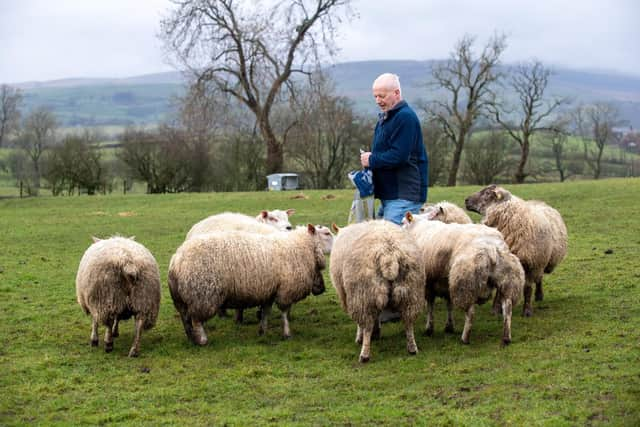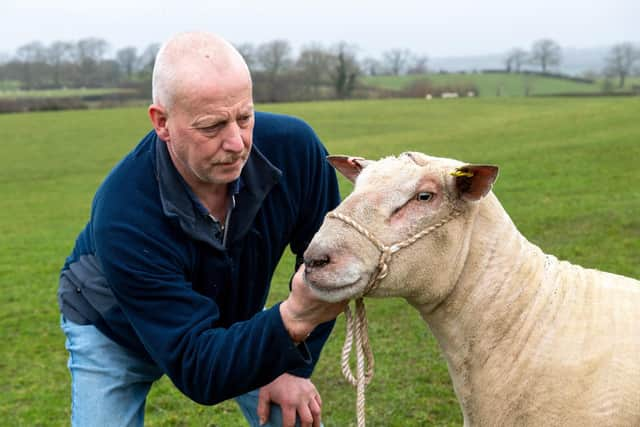Farm of the Week: Lancastrian sheep breeder who moved to Yorkshire after devastating flooding
Robert Towers moved to Greenlands Farm in Ingleton three-and-half years ago. He’d farmed in Hornby for nearly 60 years.
Robert said something had to give after the second flooding and the sale of the farm, where he had worked alongside his father, has allowed him to find somewhere that doesn’t flood and to pursue an interest which he has always held.
Advertisement
Hide AdAdvertisement
Hide Ad“Storm Desmond came in December 2015 and completely flooded our land at Hornby making it a right mess. It took out all of our hedges.


“We had a lot of low-lying ground and had the confluence of the River Lune and the River Wenning was on our land.
“We’d consistently had flooding but never as bad as we’d had with Storm Desmond and we were told it was a once in 50-years’ flood, that we would never see anything like it again, but two years later that’s exactly what happened.
“It wasn’t as big a storm, but it did more damage. We had put all the fences back from the first one, but the lower level of flooding saw all the driftwood go through the fences rather than over them.”
Advertisement
Hide AdAdvertisement
Hide AdRobert said he decided a change of lifestyle was his way forward.


“I’ve always had more of an interest in sheep than cattle but we had to have both at Hornby to make the farm viable.
“I also wanted to work in livestock marts. I enjoy them and have always loved selling and buying stock. One of my favourite parts of what I did when I farmed with Dad was to go on a Thursday to Gisburn Auction with around 30 fat lambs in a trailer and come back with two newly calved heifers.
“We sold the farm at Hornby and bought a smaller acreage here at Ingleton in 2018 where I now concentrate mainly on my pedigree Charollais breeding and work at Bentham Mart two or three days a week.”
Robert described how he started with Charollais in 1987.
Advertisement
Hide AdAdvertisement
Hide Ad“My dad’s old traditional breed of sheep was a Masham and we had a Suffolk on them. They were the most common breed to use on a Masham. I’d wanted to try other breeds of ram on the Masham and I tried a Texel but that brought about a woolly lamb.
“I borrowed a Charollais ram from a neighbour and was that impressed with the lambs that I decided I was going to have some Charollais of my own. I bought two in-lamb Charollais, one from Lancaster mart where they held a pedigree sale, and built up the flock from there.”
Robert said his synchronisation of lambing is critical to his success at auction and in the show rings.
“I AI 50 Charollais ewes in July each year of which I will lamb around 30 in the first week of December. They all lamb within a five-day period. That way I can take a week off work to be around for lambing.
Advertisement
Hide AdAdvertisement
Hide Ad“I will sell around 20 in-lamb Charollais ewes prior to lambing based upon either how I think they are looking or because they are out of synch with that first week.
“I put Beltex AI on to some of my Charollais ewes because I like the crossbred tup and you get a better-shaped lamb for the prime market and nine times out of ten you will win at the Easter lamb market with a Charollais-cross-Beltex.
“One of the things I love is going to the Easter shows and sales of prime lambs and doing well with them. I try to get to all four around me in the same week at Skipton, Junction 36, Lancaster and Bentham. I’ve won all four in a year in the past.”
Robert said that he adopts a hard line over what he keeps of his Charollais.
Advertisement
Hide AdAdvertisement
Hide Ad“I only keep what I consider to be the very best examples of the breed and only lambed 28 this year, which gave me 60 lambs. I will only keep those that have a straight back, good wool and conform to the breed’s characteristics. I keep 10 to 12 as gimmer lambs that we lamb as shearlings.
“I will keep just four of five of the very best Charollais tup lambs because there is a bit of a market around here. They are all sold as ram lambs as that’s where the better market is than shearlings, but I will keep about 10 Beltex-cross-Charollais tup lambs which I will run as shearlings and sell the following August.”
Robert said he had his proudest moment on the summer agricultural show circuit last year when he attended Westmorland County Show.
“We go to shows that have Charollais classes, including Otley, North Yorkshire County, Kilnsey, Nidderdale, Wensleydale, Cartmel, Masham and Westmorland, but we don’t go to the Great Yorkshire to show because that’s when I’ve just AI’d my flock and to take my ewes after just being inseminated would upset them.
Advertisement
Hide AdAdvertisement
Hide Ad“Westmorland County Show attracts strong competition in the Charollais classes and last year we had breed champion with a shearling ewe and reserve with a shearling tup. When you’re in the line-up with the final six and you get both it’s a great feeling. I was chuffed.”
Robert said his new life of the past three and a half years, combining farming with work at Bentham Mart certainly suits him.
“I never thought about doing anything but farming when I was younger. My dad went to market because he had to, but I have always loved them.
“Every Wednesday is the big day when dairy cows, calves, sheep and lambs are sold. We had over 6,000 sheep in last week and the last sheep went through the ring at half past midnight into Thursday morning. It’s a great atmosphere.
Advertisement
Hide AdAdvertisement
Hide Ad“But the biggest thing about being at Ingleton is my wife Jackie and I are no longer worried about floods. Every time it rained at Hornby we’d have to drop whatever we were doing and get ourselves back home to check on the sheep.”
